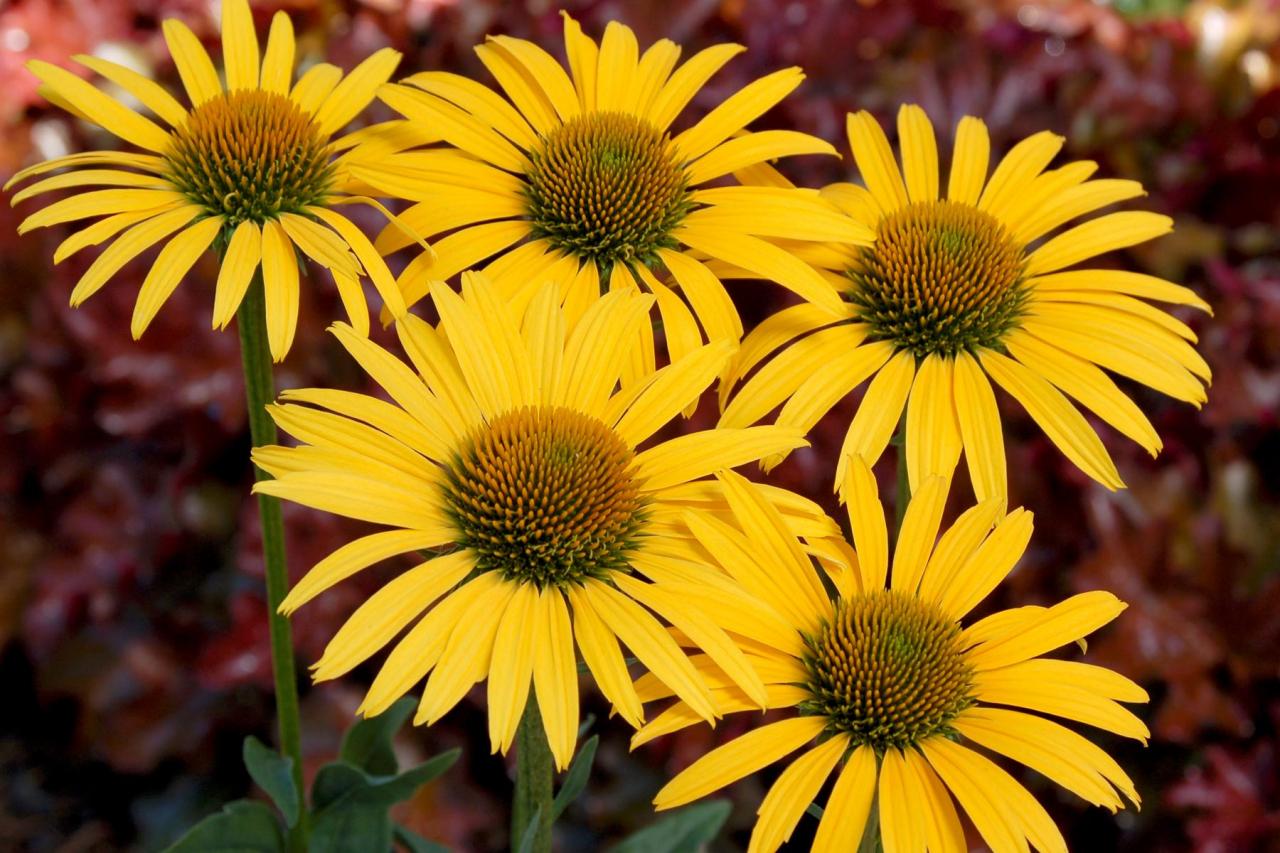
The coneflower, also known as Echinacea, is a stunning and versatile plant that has gained popularity among gardeners and herbal enthusiasts alike. With its vibrant petals and unique cone-shaped centers, coneflowers add a pop of color and texture to any garden or landscape. But there is much more to this plant than meets the eye. In this article, we will explore 13 mind-blowing facts about coneflowers that will not only impress you but also deepen your appreciation for this fascinating plant. From its rich historical significance to its remarkable medicinal properties, coneflowers truly are a remarkable addition to any garden. So, let’s dive in and discover the wonders of the coneflower!
Key Takeaways:
- Coneflowers are vibrant, easy to grow, and attract pollinators like bees and butterflies. They come in various colors and have medicinal properties, making them a fantastic addition to any garden.
- With their long blooming period, drought tolerance, and deer resistance, Coneflowers are a resilient and beautiful choice for gardens. Their self-seeding ability adds to their appeal, making them a low-maintenance option for gardeners.
The Coneflower is native to North America.
The Coneflower, also known as Echinacea, is a vibrant and popular flower native to North America. It is widely recognized for its stunning beauty and medicinal properties.
There are nine species of Coneflower.
Within the Echinacea genus, there are nine different species of Coneflower. These species vary in appearance, color, and growth habits, providing a diverse range of options for gardeners and flower enthusiasts.
The Coneflower is named after its cone-shaped center.
The Coneflower gets its name from the distinctive cone-shaped center that is surrounded by colorful petals. This cone is composed of tiny individual flowers known as florets.
Coneflowers attract pollinators.
With their vibrant colors and sweet nectar, Coneflowers are incredibly attractive to various pollinators. Bees, butterflies, and hummingbirds are commonly seen visiting these flowers, aiding in the pollination process.
They come in a variety of colors.
While the most common color of Coneflowers is purple, they also come in a range of other hues, including pink, white, yellow, and orange. This diversity adds a splash of color and versatility to any garden.
Coneflowers have medicinal properties.
For centuries, Coneflowers have been used in traditional herbal medicine for their potential health benefits. They are believed to boost the immune system, reduce inflammation, and alleviate cold and flu symptoms.
Coneflower roots are used for medicinal purposes.
When it comes to herbal remedies, the roots of the Coneflower are especially valued. They are often harvested and dried to create supplements, tinctures, and teas that can support overall wellness.
They are easy to grow.
Coneflowers are known for their resilience and adaptability. They thrive in a variety of soil types and require minimal maintenance, making them a popular choice for both novice and experienced gardeners.
Coneflowers bloom for a long period.
One of the great joys of growing Coneflowers is their extended blooming period. These flowers can produce blooms from early summer to fall, providing a continuous display of color and beauty in the garden.
They prefer full sun.
Coneflowers thrive when planted in an area that receives full sun. While they can tolerate some shade, maximum sunlight exposure ensures optimal growth and vibrant blossoms.
Coneflowers can self-seed.
Once established, Coneflowers have the remarkable ability to self-seed. The seeds they produce can fall to the ground and germinate, giving rise to new plants without any additional effort from the gardener.
Coneflowers are drought-tolerant.
With their deep taproots, Coneflowers have adapted to survive in dry conditions. They are remarkably tolerant to drought, making them a fantastic choice for gardens in arid regions.
They are deer resistant.
Due to their slightly bitter taste, Coneflowers are not a preferred choice for deer. This makes them an excellent option for gardens in areas frequented by these beautiful yet potentially destructive creatures.
With their stunning beauty, natural resilience, and various benefits, it’s no wonder that the Coneflower has become a beloved flower for gardeners and nature enthusiasts alike. Whether you’re in search of a lovely addition to your garden or a flower with medicinal properties, the Coneflower has much to offer.
So, don’t hesitate to include the 13 Mind-blowing Facts About Coneflower in your gardening journey. Explore the wide variety of colors, enjoy their extended blooming period, and reap the rewards of their medicinal potential. The Coneflower truly embodies the beauty and wonders of nature.
Conclusion
In conclusion, coneflowers are truly fascinating plants that not only add beauty to our gardens but also offer numerous health benefits. From their striking appearance to their ability to attract butterflies and bees, coneflowers are a must-have for any plant enthusiast. Their diverse range of colors and varieties make them a versatile choice for landscaping projects. Additionally, coneflowers have long been valued for their medicinal properties, providing relief from various ailments. Whether you’re a gardener looking to enhance your landscape or someone interested in herbal remedies, coneflowers are a fantastic choice. With their unique characteristics and exceptional benefits, coneflowers continue to captivate and amaze plant lovers around the world.
FAQs
1. How do I care for coneflowers?
Proper care for coneflowers includes planting them in well-draining soil, providing regular watering, and placing them in a sunny location. Deadheading spent blooms can also encourage continuous flowering.
2. Can coneflowers tolerate cold weather?
Yes, coneflowers are generally hardy plants and can tolerate cold weather. However, providing some winter protection, such as mulching the soil around the plants, can help them survive harsh winters.
3. Can I grow coneflowers in pots or containers?
Yes, coneflowers can be grown in pots or containers. Ensure that the container has proper drainage holes, use well-draining soil, and provide adequate sunlight and water for optimal growth.
4. Are coneflowers attractive to pollinators?
Absolutely! Coneflowers are known to attract butterflies, bees, and other pollinators with their vibrant flower colors and nectar-rich blooms.
5. Do coneflowers have any medicinal properties?
Yes, coneflowers have been used for centuries in traditional herbal medicine. They are believed to possess immune-boosting properties and can be used to alleviate cold and flu symptoms.
6. Can coneflowers be divided?
Yes, coneflowers can be divided every few years to maintain their health and vigor. The best time to divide them is in early spring or fall when the weather is cooler.
7. Are there different colors of coneflowers?
Absolutely! Coneflowers come in a range of colors, including pink, purple, yellow, and white. Some even feature eye-catching bi-colored petals.
8. How long do coneflowers typically bloom?
The blooming period of coneflowers can vary, but on average, they bloom from early summer to fall, providing a long-lasting display of beautiful flowers.
9. Can coneflowers be grown from seeds?
Yes, coneflowers can be grown from seeds. Sow the seeds in a well-prepared bed or containers in the spring, and they should germinate within a couple of weeks.
10. Are coneflowers deer-resistant?
Coneflowers are generally considered deer-resistant, though it may vary depending on the region and the deer population. However, it’s a good idea to monitor and take necessary precautions if deer are causing damage in your area.
Was this page helpful?
Our commitment to delivering trustworthy and engaging content is at the heart of what we do. Each fact on our site is contributed by real users like you, bringing a wealth of diverse insights and information. To ensure the highest standards of accuracy and reliability, our dedicated editors meticulously review each submission. This process guarantees that the facts we share are not only fascinating but also credible. Trust in our commitment to quality and authenticity as you explore and learn with us.


